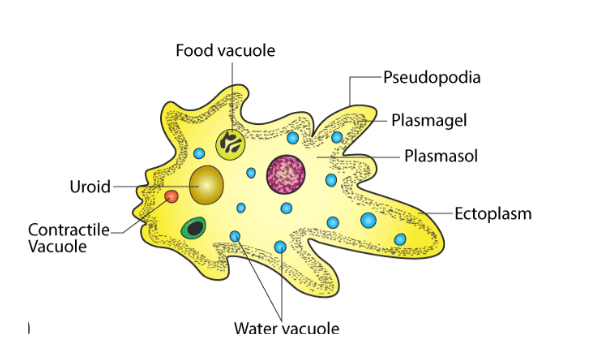Table of Contents
Introduction to Pseudopodia
In the microscopic world, cells exhibit an incredible range of adaptations that enable them to survive and thrive in various environments. One significant example of such adaptation is the formation and utilization of pseudopodia.
Pseudopodia are dynamic and temporary protrusions of the cell membrane that play a pivotal role in cellular locomotion, engulfment of particles, and various other cellular functions. This article delves into the fascinating world of pseudopodia, focusing on their definition, function, types, and prominent role in amoebae.
What is Pseudopodia?
Pseudopodia (singular: pseudopodium) are temporary cytoplasmic projections or cell membrane extensions that enable cells to move and interact with their surroundings. The term “pseudopodium” originates from the Greek words “pseudes,” meaning “false,” and “podion,” meaning “little foot.” These extensions are often irregular in shape and are used by cells for tasks such as movement, capturing prey, and engulfing particles.
Pseudopodia in Amoeba
Amoebae are among the most well-known cellular organisms that employ pseudopodia for movement. These single-celled organisms use pseudopodia to propel themselves through their aquatic environments, allowing them to find food and escape potential threats.
Define Pseudopodia
Pseudopodia are formed through the coordinated action of the cell’s cytoskeleton, especially microfilaments and microtubules. These extensions can take on various shapes and sizes, allowing cells to adapt to different conditions and challenges.
Also Check For:
Pseudopodia Function
The primary function of pseudopodia is to facilitate cell movement. They do this by extending toward the cell’s desired movement and providing temporary anchorage to the substrate. Once attached, the cell contracts its cytoskeleton, pulling the rest of its body towards the anchored pseudopodium. This coordinated process creates a flowing motion that propels the cell forward. Apart from movement, pseudopodia also play a critical role in phagocytosis – the process by which cells engulf and digest particles, such as bacteria or food particles.
Types of Pseudopodia
Pseudopodia can be categorized into several types based on their structure and formation:
- Lobopodia: These are large, blunt extensions seen in amoeboid cells like amoebae. Lobopodia are responsible for the characteristic crawling movement of amoebae.
- Filopodia: These are thin, thread-like extensions containing bundles of microfilaments. They are involved in cell adhesion and exploration of the environment.
- Reticulopodia: Found in foraminifera, these are complex networks of pseudopodia that enhance surface area for both movement and capturing prey.
- Axopodia: Seen in certain protists, these are long, stiff pseudopodia supported by microtubules. They are involved in capturing prey and defence.
Pseudopodia Diagram
The diagram shows different pseudopodia – like cell “arms” – that cells use to move around and interact. This helps us see how cells can crawl, grab things, and explore in their tiny world. It’s like a snapshot of how cells use their special parts to do different functions.

Pseudopodia Movement and Locomotion
The movement of pseudopodia involves a remarkable interplay of biochemical signals, cytoskeletal components, and membrane dynamics. As pseudopodia extend, the cell’s cytoplasm flows into these extensions, pushing the cell’s body forward. The contraction of the cytoskeleton pulls the cell’s body towards the anchored pseudopodia. This coordinated mechanism allows cells to move in an ameboid or crawling manner.
Pseudopodia in Different Species
Pseudopodia are not exclusive to amoebae; they are found in various single-celled organisms, including some protozoa and certain types of cells in higher organisms. These extensions represent an evolutionary adaptation that enables diverse cells to interact with their environment effectively.
Frequently Asked Questions (FAQs) on Pseudopodia
What is pseudopodia?
Pseudopodia are temporary cell membrane extensions that aid in cell movement and interaction with the environment.
How do pseudopodia function in amoebae?
In amoebae, pseudopodia are used for locomotion and capturing prey by extending in the direction of movement and providing anchorage to propel the cell forward.
Are pseudopodia present only in amoebae?
No, pseudopodia are found in various species, including some protozoa and certain cells in higher organisms.
What are the different types of pseudopodia?
There are several types of pseudopodia, including lobopodia (blunt extensions), filopodia (thread-like extensions), reticulopodia (complex networks), and axopodia (stiff extensions).
How does the movement of pseudopodia work?
Pseudopodia movement involves cytoplasmic flow into the extensions, pushing the cell's body forward, while cytoskeletal contraction pulls the cell towards anchored pseudopodia.









